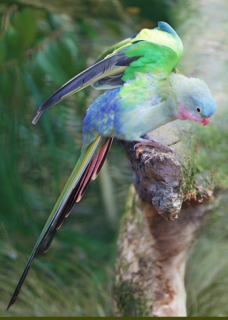Princess Parrot |
|
|
Also known as: Princess Alexandra's Parrot, Alexandra's Parrot, Princess of Wales Parakeet, Queen Alexandra's Parakeet, Rose-throated Parakeet, Spinifex Parrot
Photos
View in GalleryDid You Know?
The name "Princess Parrot" was given in honour of Princess Alexandra of Denmark, who later married the Prince of Wales Edward VII and became Princess of Wales.Academic Research
Related publications: Polytelis alexandraeSpecies Profile
Genus: Polytelis | Species: alexandrae
Size:
40cm (15.6 in)
Weight:
92g (3.2 oz)
Subspecies including nominate:
one
Colour Adult:
Male-rose/pink chin, throat, and foreneck; grey/olive breast and abdomen, abdomen variably washed with grey/purple; rose/pink thighs and lower flanks; olive/green hindneck, mantle and upper back; purple/blue lower back to upper tail coverts; wing patch yellow/green and very visible; blue/green primary feathers; olive/green tail with rose/pink margins to inner webs of side tail feathers. Bill orange/red. Female-in general duller than male; duller green upper wing coverts, less yellow; shorter tail.
Colour Juvenile:
As in adult female but in general duller. Bill pale brown/pink. Eye brown.
Call:
Given prior to taking flight or in flight calls are prolonged, harsh and chattering. While perched emits a variety of chirrupings, croaks and grunts, with some sharp, short notes.
Listen NowVideo Links:
Video 1More Information:
Content Sources:
CITES
Wikipedia
BirdLife International
Cornell Lab of Ornithology/Birds of the World
Parrots: A Guide to Parrots of the World, Juniper and Parr, 1998
ML Media Collection Catalogue 20547, Princess Parrot Polytelis alexandrae, Orenstein, Ronald, South Australia, Jul. 19 1970, Cornell Lab of Ornithology. Site
Parrots: Status Survey and Conservation Plan 2000-2004, Snyder, McGowan, Gilardi, Grajal, 2000.
Parrots of the World, Forshaw and Cooper, 1977. 2010 edition
Parrots of the World, Forshaw, 2006.
Lexicon of Parrots, Thomas Arndt.
Parrots in Aviculture, Low, 1992.
Parrots: Their Care and Breeding, Low, 1986.
Photos
View in GalleryDid You Know?
The name "Princess Parrot" was given in honour of Princess Alexandra of Denmark, who later married the Prince of Wales Edward VII and became Princess of Wales.Academic Research
Related publications: Polytelis alexandraeSpecies Care
Captive Status:
Fairly common
Longevity:
20-30 yrs
Housing:
Walk-in enclosure, minimum length 4.5m (14.7 ft).
Diet:
Small seed mix such as: canary, millet and smaller amounts of oats, buckwheat, safflower and a little hemp; limited sunflower seed; spray millet; green leaves such as: Swiss chard, lettuce, dandelion, sowthistle, chickweed; seeding grasses; rearing food made from: hard-boiled egg, wholegrain bread and carrot, all ground to a crumbly consistency; fruits such as: apple, pear, banana and oranges.
Enrichment:
Provide large flight if possible. Install multiple perches of varying sizes, to facilitate exercise by flying.
Nest Box Size:
24" (61cm) nest log with 8" (20.3cm) interior.
Clutch Size:
4-6
Incubation Time:
20 days
Fledging Age:
5 weeks
Hatch Weight:
6g (0.2 oz)
Peak Weight:
Not recorded.
Weaning Weight:
104g (3.6 oz)
Photos
View in GalleryDid You Know?
The name "Princess Parrot" was given in honour of Princess Alexandra of Denmark, who later married the Prince of Wales Edward VII and became Princess of Wales.Academic Research
Related publications: Polytelis alexandraeSpecies Wild Status
World Population:
About 7500
IUCN Red List Status:
Near Threatened
CITES Listing:
Appendix II
Threat Summary:
Not globally threatened. Wild population is very difficult to assess in this apparently very scarce, likely nomadic species with a large range. A notable absence of records of large numbers since 1963. Likely threatened by changing fire regimes, feral predators and the introduction of sheep, camels and rabbits. Possible that man-made changes to its habitat may have favoured more water-dependent competitors.
Range:
Found in interior of W and C Australia, from Great Sandy Desert and eastern Goldfields, W Australia, east to W Queensland and northern S Australia.
Habitat:
Inhabits sandy areas with scattered casuarina shrubs or where river redgums provide breeding sites near water. Also dry riverine Eucalyptus woodland, hummock grassland, Acacia scrub and mulga areas.
Wild Diet:
Diet includes seeds of grasses and herbaceous plants including spinifex, Danthonia bipartita, Portulaca oleracea, Stenopetalum anfractum, Rhynchelytrum repens and Calandrinia; seeds and possibly blossoms of Acacia and Casuarina; leaves of Codonocarpus cotinifolius, flowers of Crotalaria cunninghami, Grevillea wickhamii and Hakea suberea.
Ecology and Behaviour:
Very nomadic and difficult to track. Birds are seen in singles, pairs or small groups of up to 15. Older records exist of larger breeding colonies. Individuals feed on the ground and may be quite approachable.
Clutch and Egg Size:
4-6 rounded eggs, 27.5 x 22.0mm (1.1 x 0.8 in).
Breeding Season:
September-January, and may be prompted by the arrival of rain. Nest is in tree cavity or hollow limb.
Related Links:
BirdLife Australia
Research: The breeding and foraging ecology and abundance of the Princess Parrot during a population irruption
Photos
View in GalleryDid You Know?
The name "Princess Parrot" was given in honour of Princess Alexandra of Denmark, who later married the Prince of Wales Edward VII and became Princess of Wales.Academic Research
Related publications: Polytelis alexandraeMembers Only Resources
Please log-in now to find more research, resources and tools.
Not a Member?
Find more great information:
Gain exclusive access to 600+ pages of additional research, seminars and podcasts, specialists to ask your toughest questions, and dozens of other fun resources - when you become a WPT member.
Join Today >>

































